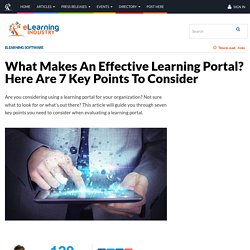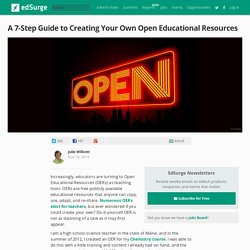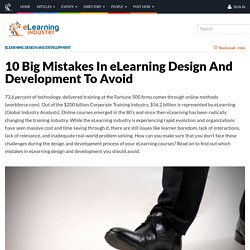

What Makes An Effective Learning Portal? Here Are 7 Key Points To Consider. What Is A Learning Portal?

A learning portal is a gateway to all the courses, resources, and instruments that facilitate teaching and learning. Technically speaking, it’s a website that acts as a repository for teaching and learning materials. It’s a place where you store all your documents, podcasts, videos, presentations, and so on. Learning portals can also include applications that facilitate communication: Discussion forums, messaging services, email, calendars, and so on.
In its simplest form, a learning portal can be a shop-front where your learners can discover or be assigned content. Whether simple or complex, a learning portal must: Let your learners get into the system and keep out those who aren’t registered.Provide easy routes for learners to navigate through the content. A 7 Step Guide to Creating Your Own Open Educational Resources. Increasingly, educators are turning to Open Educational Resources (OERs) as teaching tools.

OERs are free publicly available educational resources that anyone can copy, use, adapt, and re-share. Numerous OERs exist for teachers, but ever wondered if you could create your own? Do-it-yourself OER is not as daunting of a task as it may first appear. I am a high school science teacher in the state of Maine, and in the summer of 2012, I created an OER for my Chemistry course. I was able to do this with a little training and content I already had on hand, and the course currently has over 111,000 subscribers--and continues to grow.
I feel my students have benefitted from this OER content because it specifically addresses their background understanding, is directed at their learning objectives, and can be readily edited to meet emerging needs. So, how can you get started creating OERs? 1. Authoring Tools – Are You Up To Date? If you’re overwhelmed by the choice of authoring tools on offer you’re not alone.

Your options when looking for some advice on which tool to choose are limited to reviews of the first release evolves of major applications or more generalized guidelines on different types of authoring tools. When you’re busy building effective eLearning it’s hard to keep up with the incremental changes that add up to create important new capabilities in various software, especially if you have your own favorite or a client requires you to work with a single program. We’re going to look at the very latest updates to the most popular packages and tease out some trends that point towards where authoring tool development is heading, so you can make an informed decision for your next project. Articulate Storyline 2 Storyline is one of the most popular authoring tools in the eLearning developer’s arsenal. Articulate Storyline 2 Key updates Lectora Publisher 12 Lectora Publisher 12 Key updates Adobe Captivate 8.
3 Reasons Why We Have Interactive E-Learning. What is interactive elearning?

In previous posts we discussed different ways to interact with onscreen elements. Generally, interactions are limited to click, mouse over, or dragging interactions. Then we explored two key points when building interactive elearning. The first point is to get the users to “touch” the screen. Find ways to have them interact with onscreen elements. Now let’s look at common reasons why people interact with the elearning courses and then we can use that to build better interactive elearning. Interactive E-Learning: Course Navigation The most obvious reason why people interact with the elearning course is to navigate from one point to the next.
Of course, there are all sorts of others ways to navigate content. What I like about the slider interaction is that we are able to replace a clickable button with a draggable slider. Click here to view the slider navigation. Interactive E-Learning: Exploration Tabs Interaction: this first example is standard.
Create an Interactive Course Using a Single Image. This post gives you a two-fer: that’s two freebies for one.

I found a free desktop image made available by Anastasia Kolisnichenko. I used the free image to create an interactive course prototype for an upcoming workshop activity. The template is free for you to download and use as you wish. Below is an example of the template in action. It’s embedded on the blog page. The example above was created in Storyline 2 and uses the zoom region feature and triggers to pause the timeline. Storyline 1 (less specific control of the zoom feature)PowerPoint (no zoom). 10 Big Mistakes In eLearning Design And Development To Avoid. 73.6 percent of technology-delivered training at the Fortune 500 firms comes through online methods (workforce.com).

Out of the $200 billion Corporate Training industry, $56.2 billion is represented by eLearning (Global Industry Analysts). Online courses emerged in the 80’s and since then eLearning has been radically changing the training industry. While the eLearning industry is experiencing rapid evolution and organizations have seen massive cost and time saving through it, there are still issues like learner boredom, lack of interactions, lack of relevance, and inadequate real-world problem solving. How can you make sure that you don’t face these challenges during the design and development process of your eLearning courses?
Read on to find out which mistakes in eLearning design and development you should avoid. Based on our experience of creating thousands of hours of eLearning content, we see the following as common mistakes in eLearning design and development.